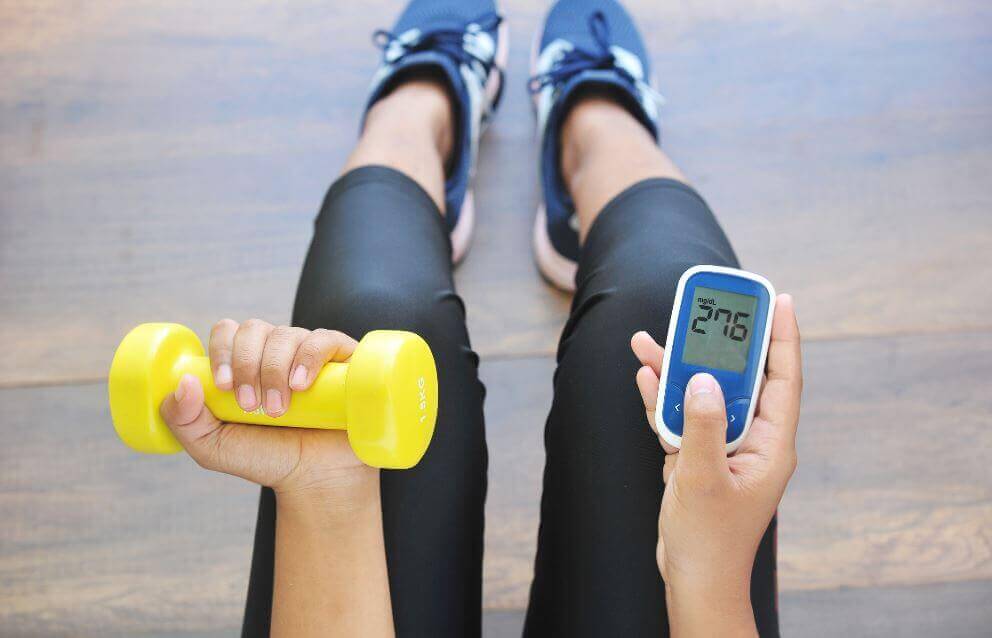Diabetes and Sports: A Complex Relationship

Many patients undergoing an endocrinology consultation do so because of diabetes. This is one of the most common metabolic diseases nowadays. In today’s article, we’ll explore the relationship between diabetes and sports, and how sports can be used as a treatment and a preventative!
Diabetes: what is it?
Diabetes mellitus is basically a metabolic disease. Its main symptom is a deficit of insulin in the blood or an inability of this hormone to act the way it should.
It’s important to realize that insulin is a hormone responsible for ‘marking’ the glucose that circulates in our blood. When these sugars are “marked”, they can be introduced into the cells by specific transporters. Insufficient secretion of insulin or loss of activity of this hormone will cause an accumulation of glucose in the blood.
Excessive blood sugar on a consistent basis is the main symptom of diabetes. Luckily, this can easily be verified by a regular blood test.
Main symptoms of diabetes
This is one of those diseases that show very few symptoms until it’s too late. When considered on its own, diabetes’ symptoms can be confusing. These include weight loss, increased appetite, and thirst, numbness of hands and feet or an increase in urination frequency. Therefore, it usually goes unnoticed in its initial stages.
Nevertheless, once the disease becomes chronic, the symptoms are more difficult to miss and might even interfere with daily life. As a chronic disease, diabetes frequently causes tissue damage, especially in the capillaries. In this case, the following symptoms stand out:
- Diabetic retinopathy. This condition usually manifests as a loss of visual prowess and is caused by a retinal capillary lesion. This can cause a loss of sharpness in vision and could even lead to permanent blindness. Some researchers have proposed a grading system because the level of damage varies from patient to patient.
- Circulatory disorders. Poor blood flow is a very distinct symptom of poorly controlled diabetes. This condition usually affects the distal microcirculation, especially in the feet. In turn, this causes a lack of blood supply in that area, which leads to a loss of sensation, tingling, and even tissue necrosis. In some cases, limb amputation becomes necessary. According to researchers, lowering sugar blood levels reduces inflammation and might have positive levels in circulatory disorders associated with diabetes.

- Coronary damage. High sugar levels in the blood flow cause damage to your coronary arteries. Once the tissue is weak, this creates an environment very prone to the formation and progression of plaques, which may cause heart disease further down the line.
Types of diabetes
Nowadays, there are many types of diabetes. Experts state that we might even discover the existence of some more. Most diabetes types have an important genetic component.
Nevertheless, the classic way to distinguish diabetes classifies the disease in two types: insulin-dependent and non-insulin dependent.
Type I or insulin-dependent diabetes
Many people know this diabetes as juvenile diabetes. This is because it has a genetic origin and usually shows signs at a young age. This genetic disorder causes the pancreas to be unable to generate insulin. For this reason, it’s called insulin-dependent. Once patients start their insulin treatment, they’ll easily manage common symptoms and complications.
Type II diabetes
This diabetes could have genetic components, but the main cause for type II diabetes is essentially environmental. This means that your lifestyle will mark whether it develops or not. Patients who develop this disease usually eat quite badly and have a sedentary lifestyle, so there’s a large amount of glucose permanently in their capillaries. Because of this, insulin becomes insensitive and ineffective and diabetes arises.
How do diabetes and sports relate to each other?
Having explained the above, we can deduce that practicing sports could be beneficial both in the treatment of the disease and as a preventive method for its appearance.
Sports as a way to treat diabetes
Sport is a great therapeutic tool for diabetic patients. Physical activity reduces blood glucose levels and could assist with their resistance to insulin, especially in the early stages of type II diabetes.
In patients with type I diabetes that don’t produce insulin, and in patients with advanced type II diabetes, whose insulin is totally unusable, this reduction in blood glucose can lead to better disease control. Doing physical activity can also help to lower the daily doses of insulin that patients need.
Diabetes and sports: as a preventative
In type I diabetes, as we’ve said, the disease has a genetic origin. Therefore, there’s no way to prevent it!

However, type II diabetes is usually preceded by a condition called prediabetes or metabolic syndrome.
In this state, insulin begins to become insensitive and glucose remains elevated for long periods of time. Physical exercise and following a healthy diet can reverse this situation and prevent you from becoming diabetic.
If, on the other hand, you already have diabetes, a proper workout routine can lower the chances of needing extra insulin. When suffering from diabetes, in almost all cases insulin will eventually become ineffective, but we can delay this fact by helping this insulin through physical exercise.
Using sports as a way to limit complications
Ultimately, the complications of microcirculation and symptoms come from an excess of blood glucose. Physical exercise allows us to have lower blood glucose, thus helping you avoid possible cardiovascular or ocular complications derived from high sugar levels in your blood.
Especially if you’re diabetic or have metabolic syndrome, sports can have very positive effects on your health. Nevertheless, our recommendation is to always consult with your doctor! A medical professional with in-depth knowledge of your specific needs will offer the best advice on how diabetes and sports can be a great combination for you.
Many patients undergoing an endocrinology consultation do so because of diabetes. This is one of the most common metabolic diseases nowadays. In today’s article, we’ll explore the relationship between diabetes and sports, and how sports can be used as a treatment and a preventative!
Diabetes: what is it?
Diabetes mellitus is basically a metabolic disease. Its main symptom is a deficit of insulin in the blood or an inability of this hormone to act the way it should.
It’s important to realize that insulin is a hormone responsible for ‘marking’ the glucose that circulates in our blood. When these sugars are “marked”, they can be introduced into the cells by specific transporters. Insufficient secretion of insulin or loss of activity of this hormone will cause an accumulation of glucose in the blood.
Excessive blood sugar on a consistent basis is the main symptom of diabetes. Luckily, this can easily be verified by a regular blood test.
Main symptoms of diabetes
This is one of those diseases that show very few symptoms until it’s too late. When considered on its own, diabetes’ symptoms can be confusing. These include weight loss, increased appetite, and thirst, numbness of hands and feet or an increase in urination frequency. Therefore, it usually goes unnoticed in its initial stages.
Nevertheless, once the disease becomes chronic, the symptoms are more difficult to miss and might even interfere with daily life. As a chronic disease, diabetes frequently causes tissue damage, especially in the capillaries. In this case, the following symptoms stand out:
- Diabetic retinopathy. This condition usually manifests as a loss of visual prowess and is caused by a retinal capillary lesion. This can cause a loss of sharpness in vision and could even lead to permanent blindness. Some researchers have proposed a grading system because the level of damage varies from patient to patient.
- Circulatory disorders. Poor blood flow is a very distinct symptom of poorly controlled diabetes. This condition usually affects the distal microcirculation, especially in the feet. In turn, this causes a lack of blood supply in that area, which leads to a loss of sensation, tingling, and even tissue necrosis. In some cases, limb amputation becomes necessary. According to researchers, lowering sugar blood levels reduces inflammation and might have positive levels in circulatory disorders associated with diabetes.

- Coronary damage. High sugar levels in the blood flow cause damage to your coronary arteries. Once the tissue is weak, this creates an environment very prone to the formation and progression of plaques, which may cause heart disease further down the line.
Types of diabetes
Nowadays, there are many types of diabetes. Experts state that we might even discover the existence of some more. Most diabetes types have an important genetic component.
Nevertheless, the classic way to distinguish diabetes classifies the disease in two types: insulin-dependent and non-insulin dependent.
Type I or insulin-dependent diabetes
Many people know this diabetes as juvenile diabetes. This is because it has a genetic origin and usually shows signs at a young age. This genetic disorder causes the pancreas to be unable to generate insulin. For this reason, it’s called insulin-dependent. Once patients start their insulin treatment, they’ll easily manage common symptoms and complications.
Type II diabetes
This diabetes could have genetic components, but the main cause for type II diabetes is essentially environmental. This means that your lifestyle will mark whether it develops or not. Patients who develop this disease usually eat quite badly and have a sedentary lifestyle, so there’s a large amount of glucose permanently in their capillaries. Because of this, insulin becomes insensitive and ineffective and diabetes arises.
How do diabetes and sports relate to each other?
Having explained the above, we can deduce that practicing sports could be beneficial both in the treatment of the disease and as a preventive method for its appearance.
Sports as a way to treat diabetes
Sport is a great therapeutic tool for diabetic patients. Physical activity reduces blood glucose levels and could assist with their resistance to insulin, especially in the early stages of type II diabetes.
In patients with type I diabetes that don’t produce insulin, and in patients with advanced type II diabetes, whose insulin is totally unusable, this reduction in blood glucose can lead to better disease control. Doing physical activity can also help to lower the daily doses of insulin that patients need.
Diabetes and sports: as a preventative
In type I diabetes, as we’ve said, the disease has a genetic origin. Therefore, there’s no way to prevent it!

However, type II diabetes is usually preceded by a condition called prediabetes or metabolic syndrome.
In this state, insulin begins to become insensitive and glucose remains elevated for long periods of time. Physical exercise and following a healthy diet can reverse this situation and prevent you from becoming diabetic.
If, on the other hand, you already have diabetes, a proper workout routine can lower the chances of needing extra insulin. When suffering from diabetes, in almost all cases insulin will eventually become ineffective, but we can delay this fact by helping this insulin through physical exercise.
Using sports as a way to limit complications
Ultimately, the complications of microcirculation and symptoms come from an excess of blood glucose. Physical exercise allows us to have lower blood glucose, thus helping you avoid possible cardiovascular or ocular complications derived from high sugar levels in your blood.
Especially if you’re diabetic or have metabolic syndrome, sports can have very positive effects on your health. Nevertheless, our recommendation is to always consult with your doctor! A medical professional with in-depth knowledge of your specific needs will offer the best advice on how diabetes and sports can be a great combination for you.
All cited sources were thoroughly reviewed by our team to ensure their quality, reliability, currency, and validity. The bibliography of this article was considered reliable and of academic or scientific accuracy.
- Yurkewicz M, Cordas M, Zellers A, Sweger M. Diabetes and Sports: Managing Your Athlete With Type 1 Diabetes. Vol. 11, American Journal of Lifestyle Medicine. SAGE Publications Inc.; 2017. p. 58–63.
- Wu Y, Ding Y, Tanaka Y, Zhang W. Risk factors contributing to type 2 diabetes and recent advances in the treatment and prevention. Vol. 11, International journal of medical sciences. 2014. p. 1185–200.
- Hauner H, Scherbaum WA. Diabetes mellitus Typ 2. Vol. 127, Deutsche Medizinische Wochenschrift. 2002. p. 1003–5.
- Kharroubi AT. Diabetes mellitus: The epidemic of the century. World J Diabetes. 2015;6(6):850.
- Kazi AA, Blonde L. Classification of diabetes mellitus. Vol. 21, Clinics in Laboratory Medicine. 2001. p. 1–13.
This text is provided for informational purposes only and does not replace consultation with a professional. If in doubt, consult your specialist.








